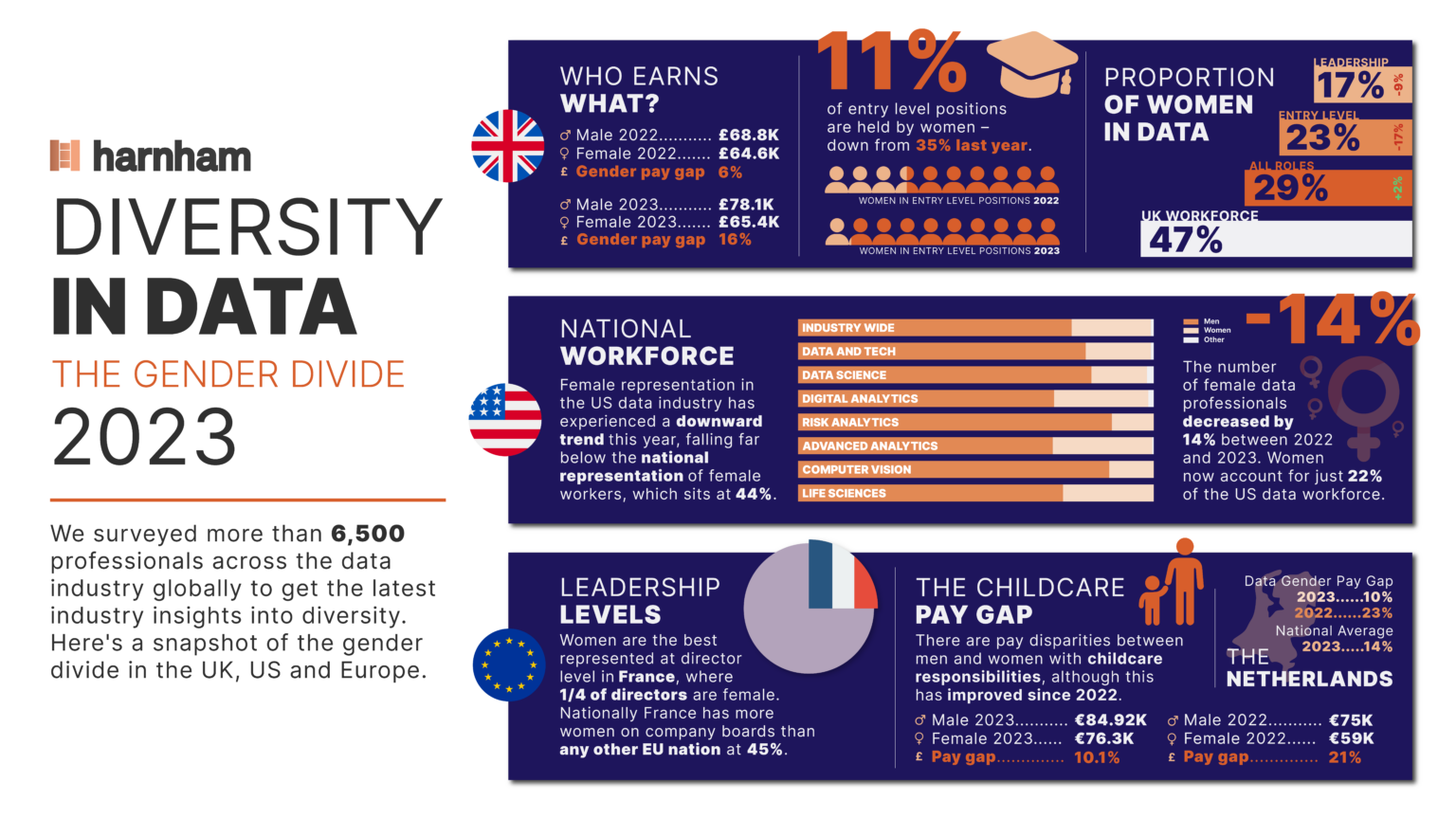
Our 2023 Diversity in Data Report has just gone live, revealing a range of interesting trends, and not all of them positive for the data industry. While it is important to celebrate our successes as a sector, it is also vital that we use reports such as these to shine a light on our weak spots, so that we can work towards resolving them.
This year’s guide involved surveying more than 6,500 professionals across the data industry in the US, UK, France and the Netherlands. It examines how fairly pay is distributed, how diversity within leadership levels is faring and what professional benefits are most appealing to different demographics.
One of the key trends highlighted within the report is that fewer females are joining the data industry at entry level across the UK, US and EU. This article will focus in on this piece of data, exploring what the findings entail, why this is important, and what steps we can take to reach better outcomes.
The data
Figures in our 2023 Diversity in Data Report present a bleak picture of female entry into the data industry. In the UK, the proportion of female professionals at entry-level has more than halved since last year, falling from 35 per cent to 11 per cent this year. Meanwhile, in the US, women accounted for 12 per cent of entry level positions in the data industry in 2023, down from 36 per cent.
There was also a decline of female representation at entry-level in the EU, albeit less severe, dropping from 37 per cent last year to 34 per cent this year. However, in the Netherlands, women dominate entry level positions, accounting for 60 per cent of roles.
Female representation at junior level has been on a steady incline over recent years, and entry-level roles have historically been the most gender diverse section of the workforce, so these statistics represent a disappointing move in the wrong direction.
The drop in the number of female data professionals has also had a knock-on effect in other areas. The gender pay gap in the UK and US has widened this year, most significantly in the UK where it has increased to 16 per cent in favour of men, up from 6 per cent last year. Meanwhile, the Netherlands has managed to narrow its gap from 23 per cent to 10 per cent, a positive step for female data professionals.
Why is it important?
Harnham is committed to broadening opportunities in the data industry to make it truly equitable and ensure that employers in the sector are reaching a diverse range of talent crucial to fostering innovation and growth. However, unless issues like the gender pay gap are resolved, a large portion of the UK, US, and EU population may feel reticent about entering the industry or completing the training necessary to reach these often-niche roles.
We have seen more positive movements in mid-level positions, however. For example, in the UK, percentages nudged closer to gender parity in mid-level roles, with women making up 37 per cent of these roles and 35 per cent of technical lead/manager positions. In the US, females occupy 39 per cent of mid-level positions and, in the EU, female representation at director level has increased from 11 per cent to 15 per cent over the past 12 months.
These figures indicate that the higher numbers of female entry-level candidates from previous years may have been retained and have progressed, which will hopefully be reflected in more senior data positions in years to come. It’s clear that when high levels of diversity at entry-level are achieved, companies are taking steps to retain this talent, and it is filtering through to higher roles.
Which is why this drop in females at a junior level could significantly impact the future of the industry and why this year’s findings should be taken as a clear sign that work needs to be done to attract more female professionals into the sector in the first place.
What can we do?
Understanding how our industry is faring is crucial and, whilst it might not always be easy to hear, talking about these issues is the key to resolving them. Many of the clients that we work with are committed to improving the diversity of their workforces and the higher figures in mid-level positions are a demonstration of this, so instead of being disheartened, we must continue to support them in their efforts.
One way of making roles more attractive, and accessible is through thoughtful allocation of benefits packages. Our Diversity in Data Report also analysed what benefits packages different types of data professionals find most useful. Female professionals consistently ranked benefits that granted them greater flexibility, higher that benefits that granted more money. For example, in the UK women considered flexible working to be a more valuable benefit than men, who favoured bonusses. Similarly, in the EU, women value holiday allowance higher than men, who prefer shares.
Ultimately, employment offerings need to be reflective of the talent that we are trying to reach and, until we eradicate issues such as the lingering gender pay gap, we will never be able to realise our potential for equity. More importantly, we will be failing to attract the best talent.
The data industry’s ability to operate as an innovative, forward-thinking field is reliant on a constant stream of high-quality talent and, if, as employers, we’re failing to reach or retain any section of the population, our growth and success will ultimately hit a ceiling. While individual organisations may be taking positive steps towards greater gender equity, it is up to all professionals to foster openness and inclusivity to reach industry-wide change.
Download the full Diversity in Data report here, or to find out more about what Harnham Group are doing to support organisations in improving the diversity of their workforces, visit our website.

























